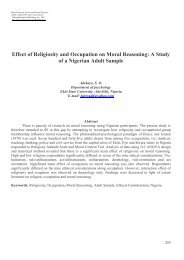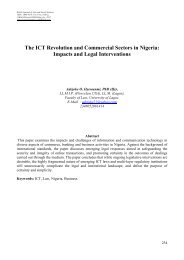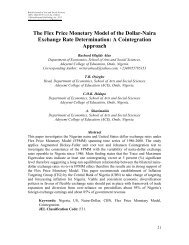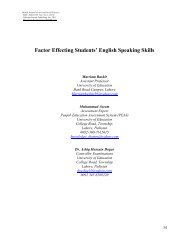The Effect of Different Learning Styles on Developing Writing Skills ...
The Effect of Different Learning Styles on Developing Writing Skills ...
The Effect of Different Learning Styles on Developing Writing Skills ...
Create successful ePaper yourself
Turn your PDF publications into a flip-book with our unique Google optimized e-Paper software.
British Journal <str<strong>on</strong>g>of</str<strong>on</strong>g> Arts and Social Sciences<br />
ISSN: 2046-9578<br />
important in this movement, not <strong>on</strong>ly in informing teaching practices but also in bringing to the<br />
surface issues that help faculty and administrators think more deeply about their roles and the<br />
organizati<strong>on</strong>al culture in which they carry out their resp<strong>on</strong>sibilities. (Diaz, D. P., & Cartnal, R. B.<br />
(1999).<br />
Informati<strong>on</strong> about learning style can help faculty become more sensitive to the differences<br />
students bring to the classroom. It can also serve as a guide in designing learning experiences that<br />
match or mismatch students' styles, depending <strong>on</strong> the teacher's purpose. Some studies show that<br />
identifying a student's style and then providing instructi<strong>on</strong> c<strong>on</strong>sistent with that style c<strong>on</strong>tribute to<br />
more effective learning. (Reid, 2002)<br />
In c<strong>on</strong>sidering learning styles, the influence the surrounding field has <strong>on</strong> a pers<strong>on</strong>’s<br />
percepti<strong>on</strong> <str<strong>on</strong>g>of</str<strong>on</strong>g> items within the field as well as its impact <strong>on</strong> the pers<strong>on</strong>’s intellectual domains and<br />
pers<strong>on</strong>ality traits have been extensively studied. Witkin (1973) has shown that a pers<strong>on</strong> whose mode<br />
<str<strong>on</strong>g>of</str<strong>on</strong>g> percepti<strong>on</strong> is str<strong>on</strong>gly dominated by the surrounding field is said to be leaning toward a fielddependent<br />
learning style. A pers<strong>on</strong> who perceives items as more or less separate from the<br />
surrounding field leans toward a field-independent learning style. Individuals with a field-dependent<br />
learning style tend to perceive the world in a global fashi<strong>on</strong>. Field-dependent learners are socially<br />
oriented and best learn material with a social c<strong>on</strong>tent. Field-dependent learners require externally<br />
defined goals and must be provided with organizati<strong>on</strong>. C<strong>on</strong>sequently, they may need more explicit<br />
instructi<strong>on</strong> in problem-solving. As teachers, field-dependent learners tend to use student-centered<br />
activities. Teachers that are field-dependent are str<strong>on</strong>g in establishing a warm and pers<strong>on</strong>al learning<br />
envir<strong>on</strong>ment. Subsequently, field – dependent teachers are less likely to provide negative feedback<br />
and evaluati<strong>on</strong> towards the student (Garger & Guild, 1984).<br />
Field-independent learners view the world more analytically. Field-independent learners rely<br />
<strong>on</strong> self-defied goals and self-structured situati<strong>on</strong>s. Teachers with a field-independent learning style<br />
tend to be more subject-centered in their instructi<strong>on</strong>. Field-independent teachers serve more as a<br />
“guide” than a “teacher” for their students. Field-independent teachers place more emphasis <strong>on</strong> the<br />
cognitive aspect <str<strong>on</strong>g>of</str<strong>on</strong>g> instructi<strong>on</strong>. Furthermore, teachers with a field-independent learning style are<br />
more likely to use an inquiry or problem-solving approach to learning due to their analytical<br />
perspective (Garger & Guild, 1984).<br />
Gee (1990) studied the impact <str<strong>on</strong>g>of</str<strong>on</strong>g> learning style variables in a live telec<strong>on</strong>ference distance<br />
educati<strong>on</strong> class. <str<strong>on</strong>g>The</str<strong>on</strong>g> purpose <str<strong>on</strong>g>of</str<strong>on</strong>g> the study was to examine the influence <str<strong>on</strong>g>of</str<strong>on</strong>g> student learning style<br />
preference, in an <strong>on</strong>-campus or distance educati<strong>on</strong> remote classroom, <strong>on</strong> student achievement in the<br />
following areas: course c<strong>on</strong>tent, course completi<strong>on</strong> rates, and attitudes about learning. Both distance<br />
and <strong>on</strong>-campus groups were taught simultaneously by the same instructor, received identical course<br />
c<strong>on</strong>tent, and both groups met weekly. Gee administered the Canfield <str<strong>on</strong>g>Learning</str<strong>on</strong>g> <str<strong>on</strong>g>Styles</str<strong>on</strong>g> Inventory<br />
(CLSI) (Canfield, 1980). Students in the distance learning class who possessed a more independent<br />
and c<strong>on</strong>ceptual learning style, had the highest average scores in all <str<strong>on</strong>g>of</str<strong>on</strong>g> the student achievement areas.<br />
People with the lowest scores in student achievement in the distance learning course had a more<br />
social and c<strong>on</strong>ceptual learning style. Students with both a social and applied learning style performed<br />
much better in the <strong>on</strong>-campus class. <str<strong>on</strong>g>The</str<strong>on</strong>g> outcomes <str<strong>on</strong>g>of</str<strong>on</strong>g> the Gee study suggested that successful<br />
distance educati<strong>on</strong> students favored an independent learning envir<strong>on</strong>ment while successful <strong>on</strong>campus<br />
students showed a preference for working with others. <str<strong>on</strong>g>The</str<strong>on</strong>g> relatively small sample <str<strong>on</strong>g>of</str<strong>on</strong>g> 26<br />
students suggested that additi<strong>on</strong>al work is needed to further explore this relati<strong>on</strong>ship.<br />
<str<strong>on</strong>g>The</str<strong>on</strong>g>re are many approaches to identify students' learning style preferences, various learning<br />
style instruments for native speakers <str<strong>on</strong>g>of</str<strong>on</strong>g> English have been developed, for n<strong>on</strong>-native speaker <str<strong>on</strong>g>of</str<strong>on</strong>g><br />
English, O'Brien's (1990) learning channel preference checklist and Reid's (1987) perceptual learning<br />
style preference questi<strong>on</strong>naire are am<strong>on</strong>g the better-known <str<strong>on</strong>g>of</str<strong>on</strong>g> the learning style assessment<br />
instruments in the ESL/EFL field (Wintergerst, et al., 2003). When teachers help students discover<br />
their own learning preferences, it is possible to help students develop more versatile approaches to<br />
222








